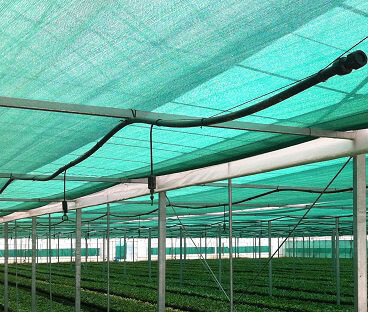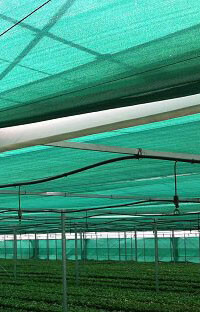- All
- Product Name
- Product Keyword
- Product Model
- Product Summary
- Product Description
- Multi Field Search
Views: 0 Author: Shijiazhuang Qibang Imp&Exp Co.,Ltd. Publish Time: 2023-02-13 Origin: http://www.sjzqibang.com/








If you're looking for sun shade net to protect your plants from the sun, you may wonder if green or black shade net is better. Both have their pros and cons, so it is important to weigh your options before making a decision. Keep reading to learn more about black and green shade nets, so you can choose the best one for your needs. In this article, now you will learn:


Green shade nets are made of a lighter-colored fabric that allows more light to pass through than black nets. They are ideal for protecting plants that require partial shade, such as herbs, flowers, and some vegetable crops like tomatoes and peppers.
Green shade netting also provides protection against UV rays and reduce the temperature inside the greenhouse or shade house.The lighter color of green shade cloth reflects some of the sunlight, which can be beneficial for plants that require moderate sunlight.
Additionally, green shade nets are visually appealing and can blend well with the surrounding landscape. However, the lighter color of green sunshade nets means that they provide less shade than black sun shade net. This might be a disadvantage for plants that require a high degree of shade, and they may not provide adequate protection against intense sunlight.

Black shade mesh is a dark-colored fabric made of high-density polyethylene (HDPE) material that blocks a higher percentage of sunlight than green shade mesh. They are ideal for protecting plants that require a high degree of shade, such as ferns, orchids, and some vegetable crops like lettuce and spinach.
Black sun shade nets are also ideal to use for excellent protection against ultraviolet (UV) rays and reduce the temperature inside the greenhouse or shade house.
However, black shade fabric has a few drawbacks. The dark color absorbs heat, which can lead to an increase in temperature inside the greenhouse or shade house. This can be detrimental to plants that require cooler temperatures. Additionally, black shade cloth may be visually unappealing, which can be a concern if the shade house is visible to the public.
In conclusion, whether green or black shade net is better for plants depends on the needs of the specific plants and the weather conditions. Black sun shade nets are ideal for plants that require a high degree of shade and protection against UV rays, while green shading nets are better suited for plants that require partial shade and moderate sunlight.
Green shade netting provides shade to plants while still allowing some light to pass through. This helps protect plants from excessive sunlight, which can cause heat stress and sunburn.
Green shade netting can help reduce water loss by providing shade and keeping the surrounding air cooler. This can be especially important in hot and dry climates.
By providing shade, green shade netting can help control the temperature and humidity levels around plants. This can be beneficial for plants that require specific conditions for optimal growth.
Green shade netting can provide some protection from wind, which can help prevent damage to plants.
Green shade netting can provide an attractive backdrop for plants, creating a more visually appealing environment.
Black shade netting is designed to block out more sunlight than green netting, providing better protection from excessive sunlight and heat stress.
Black shade netting can help reduce water loss by blocking more sunlight and keeping the surrounding air cooler.
Black shade netting can help prevent insect damage by reducing the amount of light that attracts pests.
Black shade netting can help promote healthier plant growth by providing a more consistent environment with less fluctuation in temperature and moisture levels.
Black shade netting can provide better protection from harsh weather conditions such as hail or heavy rain, helping to prevent damage to plants.




Both black and green shade nets are used for similar purposes, such as providing shade and reducing the temperature for plants, but they have different characteristics and cost structures.
Black shading nets are typically made of high-density polyethylene (HDPE) and have a higher shading coefficient than green shading nets. This means that they provide greater shade and more effective cooling. Black sun shade nets are also generally cheaper than green shade nets, as they are easier to produce and require less material.
Green shade nets, on the other hand, are made of a combination of HDPE and color pigments, which give them a green appearance. They have a lower shading coefficient than black shade nets and allow more light to penetrate. This can be beneficial for certain types of plants that require more sunlight, but may be less effective at reducing heat. Green shade screen tends to be more expensive than black shade cloth, as they require additional materials and processing.
Ultimately, the choice between black and green shading mesh depends on the specific needs of your plants and your budget. If you require greater shading and cooling, black shade nets may be more economical. If you need more light penetration and are willing to pay a premium, green shade nets may be the better choice.
Choosing the right type of sun shade net for your plants is an important decision, as it can have a significant impact on their growth and health. Here are some factors to consider when selecting sun shade net:
The shading coefficient is a measure of how much light is blocked by sun shade net. Different plants have different requirements for light, so choose a shade net with a shading coefficient that suits the needs of your plants. For example, plants that require full sunlight may need a shading net with a lower shading coefficient, while shade-loving plants may benefit from a higher coefficient.
Sun shade nets are typically made of high-density polyethylene (HDPE) or polypropylene (PP). HDPE is more durable and long-lasting, while PP is lighter and more affordable. Consider your budget and the expected lifespan of the shading mesh when choosing the material.
Sun Shade netting is available in various colors, including black, green, and white. Black sun shade nets provide the most shading and are best suited for hot climates, while white shade nets reflect light and are better for cooler climates. Green shade nets are a good compromise, providing some shading while allowing some light penetration.
Consider the size and shape of your plants when selecting sunblock net. The net should be large enough to cover the entire plant, but not so large that it blocks too much light or interferes with air circulation.
Choose a shade net from a reputable supplier that uses high-quality materials and manufacturing processes. Look for shade nets that are UV-stabilized, tear-resistant, and have reinforced edges to ensure durability.
By considering these factors and choosing sun shade net that suits the specific needs of your plants, you can help them thrive in any environment.




Shade netting is an incredibly useful tool for gardeners to protect their plants from harmful elements like blazing summer sun or harsh winter winds.
Shade nets come in various colors, but black and green shade netting provide the best protection from the sun's rays or wind. As such, it's important to study how shade netting works and what shade netting is best for your plants.
Make sure you choose a shade cloth to help reflect light away without blocking any much-needed air circulation for your plants – this might mean using a lighter sunscreen net in the summer months.
When installing your shade netting, ensure it's evenly distributed over the area you're trying to protect and firmly attached to poles, so no gaps are left open that exposed plants to enhanced sunlight or wind exposure.
Regularly check on the shade net you've laid down, as its fabric can degrade over time, leaving your plant exposed!
Following these easy tips will help ensure that your shade net offers adequate protection for all of your agriculture vegetables – no matter if you choose black or green shade nets!
There are many factors to consider when choosing the right type of shade netting for your plants, including the level of protection needed, the climate, and the price. When selecting sunshade netting, it is important to consider the type of plants you will use it for and the environment they will be in.
If you have any questions about which type of shade netting is right or would like to buy now, please get in touch with Shijiazhuang Qibang. Our team of experts would be happy to assist you in selecting the best product for your needs.
Keep Learning:
Green Vs White Shade Cloth – What Is The Difference?
White vs Black Shade Cloth: Which Is Better For Your Plants?